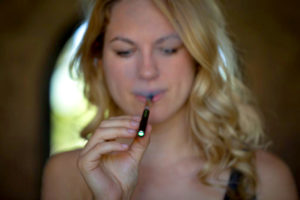
Most people who use marijuana these days use the vaporizing method. This is because vaporizing is the healthiest way to consume the plant. What they may not realize is how important the proper temperature is to their experience. When marijuana is heated to the right level, the terpenes and cannabinoids are efficiently vaporized, which results in the optimal medicinal and recreational outcome.
The Best Temperature
Clinical professor and emergency doctor Ian Mitchell, who teaches at the University of British Columbia, said the correct temperature range for marijuana vaporization is 347 to 392 degrees Fahrenheit. Mitchell noted that recent studies indicated some vaporizers use 410 degrees Fahrenheit to extract cannabinoids as a basis for the best temp to vape weed.
Medical cannabis researcher Dr. Arno Hazekamp of the Netherlands said that generally, 410 degrees provides the most efficient evaporation of cannabinoids and terpenes and the smoothest vapor. Hazekamp specializes in marijuana study at the Bedrocan BV in Veendam.
Temperature Differences
If marijuana is vaporized at a temperature lower than 356 degrees Fahrenheit, the user will be inhaling mostly terpenes because cannabinoids cannot evaporate at that level. Hazekamp said that lower temperatures are ideal for those who prefer less intensity with their high and wish to remain awake through the experience.
Further research conducted in the Netherlands indicated that higher vaporization temperatures resulted in more cannabinoids. As an example, when a Volcano brand vaporizer was set to 338 degrees Fahrenheit, it produced cannabinoids at only 24 percent. When the temperature was raised to 446 degrees, the yield increased to 77 percent. Mitchell said the optimal THC extraction point is 446 degrees, but using lower temperatures is better from a health standpoint.
Users should not use temperatures above 455 degrees because it will result in a harsh vapor and could possibly burn. Hazekamp said that scenario would produce the same toxic compounds that are found in cigarettes, which could eventually result in cancer.
THC and CBD
While some users may adjust the vaporizing temperature up or down to find the desired high with CBD or THC, it probably would not make a noticeable difference. The reason for this is the boiling points for the respective cannabinoids are only 18 degrees apart. Vaporizers cannot be set to such a fine accuracy.
Mitchell said that if users want to separate the two cannabinoids, it is better to do so with the sample than to attempt it with temperature adjusting in the vaporizer. Hazekamp added that since 410 degrees was the optimal setting to experience both cannabinoids and was easy to remember, there was no reason to adjust it up or down.
Other Considerations
For people new to vaporizing marijuana, specific temperatures are often suggested to make the experience easier. Hazekamp said that there are several factors that can have an effect on the vaporizing temperature. The main consideration is the moisture content of the user’s cannabis. The first thing to boil off in the vaporizer is the water inside of the plant.
Hazekamp added that the type of vaporizer the user chooses will make a large difference in experience. A convection-type vaporizer, such as the Volcano model, is the most efficient because it transfers heat directly to the plant. The one drawback is it may cause cannabis to evaporate even if the user is not currently in the act of inhaling.
Mitchell said other lower-quality vaporizers, like conduction and vape pens, had a tendency to develop hotspots, which created a difficulty with temperature regulation and offered an unpredictable experience.
With vaporizing, it is best practice to purchase a quality machine and experiment with different temperatures to discover what works for the desired type of high.
